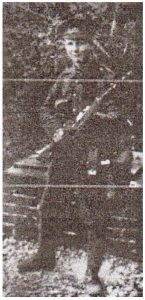Royal Marine Light Infantry (Portsmouth Battalion)

George Frederick Morgan was born at Great Malvern on 9 January 1895, one of five children born to George Morgan and his wife Clara. By the time of the 1901 Census the family had moved to Leonard Road, Tredworth, Gloucester.
Upon leaving school George was employed as a grocer’s errand boy and then became an engine cleaner which was his occupation at the time of his enlistment into the Royal Marines (RM), at Bristol on 26 October 1914.
His initial posting was to the Plymouth Battalion of the Royal Marine Light Infantry (RMLI) before transferring to the Portsmouth Battalion in the following December.
After training at the RM Depot at Deal and with the battalion at Blandford Forum, he arrived at Lemnos in the Aegean on 11 March 1915, in anticipation of the Gallipoli landings.
The RMLI battalions were now part of the 3rd RM Brigade.
Private Morgan first set foot on the Gallipoli Peninsula on 28 April 1915, landing at Gaba Tepe which is just south of the Australian positions at ‘Anzac’.
The capture of the village of Krithia and in particular the 700 foot high hill of Achi Baba had been a first day objective of the 24 April landings at Cape Helles. However, despite concerted attempts by both the British and French, Turkish resistance was such that they were never captured.
The 12 July 1915 saw one of these attempts. 52 Division, under Lieutenant General Hunter-Weston mounted an attack along a ravine known as Achi Baba Nullah. It was believed that the Turks had three lines of defences in that sector, when in effect there were only two and this caused confusion and disorientation amongst the attackers and progress stalled.
Overnight and during the next day the Turks mounted counter-attacks and Hunter-Weston called up the RM Brigade to renew the attack, in conjunction with the French.
Three RMLI battalions were involved but due to a mix up with orders Chatham Battalion never moved and left Nelson and Portsmouth on their own.
Despite good communication trenches being available, these battalions moved forward from the original British front line over 400 yards of open ground and once again the faulty intelligence regarding the exact depth of the Turkish lines led to confusion and the failure of the attack.
Portsmouth Battalion lost every officer but one in the attack and almost 50 other ranks killed.
The majority have no known grave. Private Morgan suffered a gun shot wound to the abdomen but it would appear that he was collected from the battlefield and taken to a medical facility as his date of death is recorded as being a day later, on 14 July and he was buried in the Lancashire Landing Cemetery, where his headstone bears the inscription: Died as he lived; game to the last.
Private Morgan is commemorated on the Gloucester War Memorial.
Research by Graham Adams
